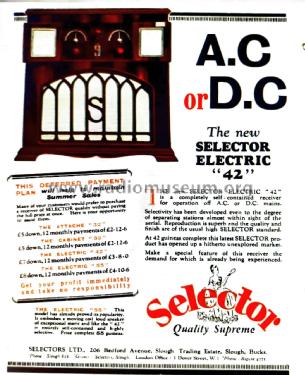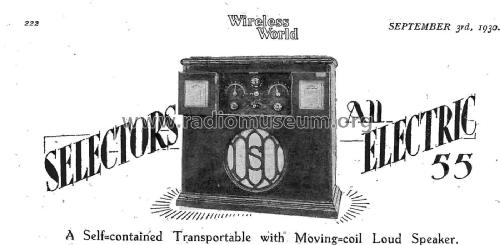Electric 55
Selector (Brand), Selectors Ltd.; Slough, London
- Country
- Great Britain (UK)
- Manufacturer / Brand
- Selector (Brand), Selectors Ltd.; Slough, London
- Year
- 1930 ?
- Category
- Broadcast Receiver - or past WW2 Tuner
- Radiomuseum.org ID
- 347887
- Number of Tubes
- 5
- Number of Transistors
- Semiconductors
- Metal-rectifier
- Main principle
- TRF with regeneration; Screengrid 1926-1935
- Wave bands
- Broadcast, Long Wave and Short Wave.
- Power type and voltage
- Alternating Current supply (AC)
- Loudspeaker
- Electro Magnetic Dynamic LS (moving-coil with field excitation coil)
- Material
- Wooden case
- from Radiomuseum.org
- Model: Electric 55 - Selector Brand, Selectors Ltd.
- Shape
- Tablemodel, with any shape - general.
- Notes
-
Electric 55
This model has already proved its popularity. lt embodies a moving coil loudspeaker of exceptional merit and like the 42 is entirely self-contained and highly selective.
Designed for operation from A.C. mains this receiver incorporates a self-contained frame aerial and is housed in a hand-polished mahogany cabinet standing on a ball-bearing turntable. It may therefore be classed as a " Table Model Transportable," and should recommend itself to those who may wish to enjoy the broadcast programme in different rooms from time to time.
An usually interesting feature of the specification is the provision of a moving-coil loudspeaker, an item which at once invests the receiver with an air of distinction.
The coupling employed in the single screen-grid. H.F. stage is in principle the same as in Selector portables. It is in essence tuned anode coupling but includes several refinements worthy of favorable comment. The tuning condenser, instead of being connected directly across the anode coils, is joined between the anode and earth, a fixed series condenser of comparatively large capacity being inserted as a safety measure in the event of the vanes of the variable condenser short-circuiting. With this arrangement not only is the condenser spindle at a fixed H.F. potential but is also at earth potential in relation to the H.T. supply and can be bolted directly to the screening box. The anode coils for medium and long waves and also a coil for the reaction is connected in series, the longwave coil being shorted out by the wave-range switch. The medium-wave coil is in two single-layer sections connected astatically, and the reaction coil which serves for both long and short waves is capacity fed from the anode of the leaky grid detector. The reaction condenser is of the three-element differential type and maintains a constant by-pass capacity in the detector anode circuit.
The aerial circuit is straightforward, the frame being wound in two sections, one of which is short-circuited for reception on medium waves. Terminal sockets are provided for an external aerial and earth, the aerial being connected to a tapping point on the medium-wave section of the frame.
Indirectly heated valves are used in the H.F. stage (S.4.V), detector, and first L.F. stages (164.V); but the power valve, a P. 625, is directly heated with raw A.C. Transformer coupling is employed for both L.F. stages, the two transformers being assembled in a separate screening box. The rectifier for H.T. supply is a Philips Type 1560 full-wave valve, and for convenience in servicing is mounted together with the components of the receiving circuit in the top half of the cabinet.
The bottom half of the cabinet contains the moving-coil loudspeaker, mains transformer, grid bias, and decoupling resistances, and smoothing equipment. The loudspeaker is a Magnavox unit complete with a metal-oxide rectifier for supplying D.C. to the field winding and output transformer for coupling to the P.625 output valve.The set is also available to special order in oak, walnut, and other finishes.
- Price in first year of sale
- 55.00 GNS
- Mentioned in
- The Wireless and Gramophone Trader, vol. XXII, 303, June 7th 1930, p.54
- Literature/Schematics (1)
- Wireless World (The), London (WW, 79) (Wireless World Sep 3, 1930, Page 222.)
- Author
- Model page created by Miguel Bravo-Cos. See "Data change" for further contributors.
- Other Models
-
Here you find 12 models, 6 with images and 0 with schematics for wireless sets etc. In French: TSF for Télégraphie sans fil.
All listed radios etc. from Selector (Brand), Selectors Ltd.; Slough, London

